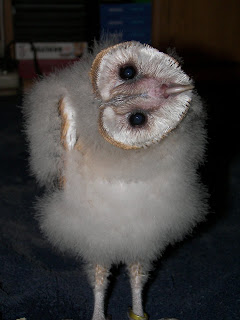World Bird Sanctuary Wildlife Hospital facing imminent closure.
“Unless the World Bird Sanctuary Wildlife Hospital generates donations of $40,000 in the next 60 days, we will be forced to close the 35-year old hospital on June 1st,” says a solemn Walter C. Crawford, Jr., Executive Director of World Bird Sanctuary.
An injured Barred Owl receives treatment from Drs. Eric and Stacey Siebel-Spath,who so generously donate their services, while two volunteers look on
The raptor hospital admits and treats approximately 300 sick, injured or orphaned birds of prey per year, and has released more than 4,000 birds back to the wild! It has achieved this over the last 35 years with no state or federal funding, instead relying entirely on donations from members of the public to keep its doors open.
Wildlife Hospital financial challenges compounded by Sunday’s windstorm
In addition to the regular financial challenges that the hospital is facing, the windstorm on Sunday 28th March added another cost to the wildlife hospital. The 130ft long physical therapy and flight cage was extensively damaged by a tree that was blown over by the wind. Breaking through the top and side of the cage, damage is estimated at around $5,000. “Fortunately, the Bald Eagle currently housed in the cage was unharmed and did not escape, but we now have no cage big enough for the eagle to exercise its flight muscles and build up strength, threatening its chances of release back into the wild,” explains Crawford.
“There are no other facilities in the state that are equipped to deal with the 300 or so birds that we receive every year. Most of the birds are admitted to the hospital as a result of human encounter – collisions with vehicles, collisions with windows, being attacked by pets, being accidentally shot or trapped, or being maliciously attacked. As a result, we have a responsibility to do what we can to return them to their natural habitat. They require special handling, diets and facilities to give them the best chances for return to the wild. Without our wildlife hospital, I don’t know what will happen to all these sick and injured birds that will need treatment.”
The World Bird Sanctuary Wildlife Hospital needs immediate funding.
“The Wildlife Hospital does not charge for services and earns no income of its own. With the recent recession our supporters have been as generous as they can be, but the hospital still needs help,” says Crawford. “We are appealing to our supporters in our community to help us in any way that they can.”
In January 2005 the World Bird Sanctuary Wildlife Hospital moved from Tyson Research Center (a facility closed to the public) to the current site, which is open to the public daily from 8:00 am to 5:00 pm, with no admission fee. This increased visibility, coupled with current economic conditions that have forced many smaller wildlife rehabilitation centers around the country to close, has contributed to the Wildlife Hospital’s increased caseload. This in turn has resulted in rising operating costs for the World Bird Sanctuary’s Wildlife Hospital.
“In addition, the economic recession has reduced discretionary income among our support base, and the recent tragedies in Haiti and Chile have forced our supporters to make even more difficult choices regarding which causes they donate to, and how much they can donate to each,” explains Walter, “At World Bird Sanctuary we have already taken steps to reduce unnecessary expenditure, such as:
- Freezing salaries and new hires for at least one year.
- The Executive Director has taken a pay reduction.
- Elimination of travel and related expenses for attendance at conferences and seminars.
- We are successfully aggressively pursuing in-kind donations of products and services that we would normally pay for.
- We are reducing utility costs with conservative measures put into effect that will reduce any possible wastes of electricity and water.
- We have laid off two staff and extended the work week of all current staff. We have reduced staff housing and vacation benefits. We cannot lay off any further staff without severely impacting our ability to deliver on-site visitor services, off-site environmental education programs and care of our animals.”
While we receive volunteer veterinary services from three veterinarians, and we have a dedicated volunteer base to help us care for the animals, we still have expenses that need to be covered. Costs to run the Wildlife Hospital are currently budgeted at $40,000.00 per year. The highest costs incurred include medication, food, supplements, other medical supplies, veterinary diagnostics and maintaining bird housing, and costs associated with running and maintaining the hospital building.
The World Bird Sanctuary wildlife hospital has never earned any income. Instead it has been supported by other departments within the organization. However, with the continuing financial difficulties that we and our donors are facing, we can no longer afford for the Education and Behavioral and Training Departments to subsidize the running costs of the Wildlife Hospital. Closing the Wildlife Hospital is a difficult and heartbreaking decision to make, but one that may be necessary if we don’t receive funding.
About the World Bird Sanctuary
The World Bird Sanctuary’s mission is to preserve the earth’s biological diversity and to secure the future of threatened bird species in their natural environments. The World Bird Sanctuary works to fulfill this mission through education, propagation, field studies and rehabilitation.
The World Bird Sanctuary (501(c) (3) non-profit) was founded in 1977 by Walter C. Crawford, Jr., and is one of North America’s largest facilities for the conservation of birds.
We are essentially looking for a few generous individual donors or a corporate sponsor who would like to sponsor the Wildlife Hospital for one year, with naming rights. If you or anyone you know can help, please call Catherine at 636-225-4390 ext. 102.
If you would like to make an online donation to our wildlife hospital click here
If you would like to mail a donation to the wildlife hospital you can send it World Bird Sanctuary Wildlife Hospital Appeal, 125 Bald Eagle Ridge Road, Valley Park MO 63088


















































